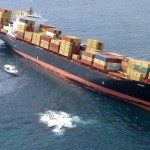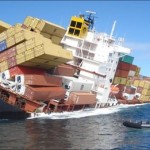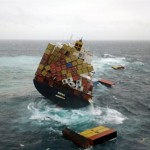October 2011
Disaster at sea! Oilspill of container Vessel Rena. MiniMax R3 was used by Maritime Goverment New Zealand.
Rena incident overview
 Early in the morning of 5 October 2011, the cargo vessel Rena struck Astrolabe Reef 12 nautical miles off Tauranga and grounded.
Early in the morning of 5 October 2011, the cargo vessel Rena struck Astrolabe Reef 12 nautical miles off Tauranga and grounded.
The 21-year-old 236 metre Liberian-flagged cargo vessel was en route from Napier to Tauranga and travelling at around 21 knots when it struck. Its bow section was wedged on the reef, and its stern section was afloat. Two of its cargo holds flooded and several breaches were identified in the hull. There were 25 crew on board Rena at time of grounding.
Rena was carrying 1,368 containers and 1,733 tonnes of heavy fuel oil (HFO) on board at the time of grounding. An oil leak was detected on the night of night 5 October and a salvor, Svitzer, was appointed by the vessels owners and insurers the next day.
The salvage team began working around the clock in extremely dangerous conditions to secure the vessel and make preparations for the complex task of pumping the HFO off.
The salvors began removing the estimated 1,350 tonnes of oil in various tanks on Rena on 9 October, but were hampered by bad weather, equipment breakdown and hazardous and changeable conditions.
 A storm overnight on 11 October resulted in the loss of an estimated 350 tonnes of oil from Rena, some of it washing up at various points along the Bay of Plenty coastline. Continuing bad weather the following night saw 86 containers lost overboard. A further 5–10 tonnes of oil was lost from the vessel overnight on 22–23 October.
A storm overnight on 11 October resulted in the loss of an estimated 350 tonnes of oil from Rena, some of it washing up at various points along the Bay of Plenty coastline. Continuing bad weather the following night saw 86 containers lost overboard. A further 5–10 tonnes of oil was lost from the vessel overnight on 22–23 October.
Oil spill response personnel and volunteers, including large numbers of locals, worked to clean oiled beaches and recover debris from the containers. Wildlife experts from the National Oiled Wildlife Response Team treated oiled birds, including little blue penguins and pied shags, and pre-emptively caught 60 rare New Zealand dotterel to prevent them becoming oiled. (These birds were later re-released back into cleaned environments in a staged released programme.)
 Over 1,300 tonnes of HFO was eventually recovered from Rena, with all of the accessible oil removed by 15 November. Containers lost overboard during bad weather were intercepted and recovered, where possible, along with dispersed container contents that washed up. Container removal operations from Rena began once all of the oil had been removed, with the first container lifted off on 16 November 2011. By 26 December, a total of 341 containers had been removed.
Over 1,300 tonnes of HFO was eventually recovered from Rena, with all of the accessible oil removed by 15 November. Containers lost overboard during bad weather were intercepted and recovered, where possible, along with dispersed container contents that washed up. Container removal operations from Rena began once all of the oil had been removed, with the first container lifted off on 16 November 2011. By 26 December, a total of 341 containers had been removed.
On 8 January 2012, Rena separated into two pieces and an estimated 200–300 of the approximately 830 remaining containers were lost overboard. The condition of the vessel had been gradually deteriorating during the time it was grounded on the reef, with more accelerated deterioration during stormy weather.
 On Tuesday 10 January the stern section of Rena began to change significantly, with about 75 percent underwater by 10am. The stern section completely sank in early April, with the front of the section in around 23 metres of water and the rear in around 65 metres.
On Tuesday 10 January the stern section of Rena began to change significantly, with about 75 percent underwater by 10am. The stern section completely sank in early April, with the front of the section in around 23 metres of water and the rear in around 65 metres.
Salvage is continuing and is being managed by Resolve Fire and Salvage. Container recovery is being managed by Braemar Howells, and beach monitoring is being carried out by the Bay of Plenty Regional Council.
The Rena’s insurers The Swedish Club have indicated they are exploring an option to leave part of the Rena on Astrolabe Reef. This would require an application under the Resource Management Act
Bron : Maritime Goverment New Zealand
